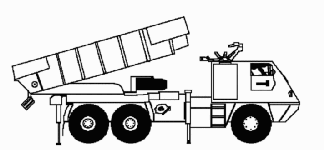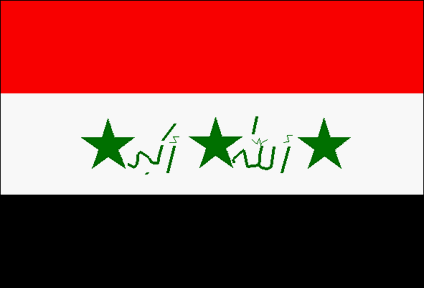ASTROS (Artillery SaTuration ROcket System)
Sajil-60
The Astros II multiple rocket launcher was the most profitable weapon produced by Avibr�s. It can launch rockets of different caliber: SS-30 rockets up to thirty kilometers; SS-40 rockets, forty kilometers; and SS-60 rockets, sixty kilometers. In the 1980s, Avibr�s sold an estimated sixty-six Astros II artillery systems to Iraq and an unspecified number to Saudi Arabia, Bahrain, and Qatar. Total sales of the Astros II between 1982 and 1987 reached US$1 billion. The Sajil-60 is an Iraqi license-built version of the Brazilian SS-60
The ASTROS (Artillery SaTuration ROcket System) II is a modular multiple rocket launcher capable of firing three different caliber wrap-around fin rockets (for improved accuracy) using several types of warheads. The system was developed and manufactured by Avibras Aerospatial S.A. of Sao Paulo, Brazil. The universal modules enable the system to accomplish fire missions with ranges from 9 to 90 kilometers. The ASTROS II system consists of the following vehicles:- Universal Multiple Launcher (AV-LMU),
- Ammunition Supply Vehicle (AV-RMD),
- Command and Control Vehicle/Fire Control Unit (AV-VCC),
- Mobile Workshops (for field maintenance), and the
- Optional Electronic Fire Control Unit (AV-UCF).
Avibr�s Aerospace Industry (Avibr�s Ind�stria Aeroespacial S.A.--Avibr�s) was established in 1961. Engineers associated formerly with the CTA created Avibr�s as a private aerospace firm. In 1964 Avibr�s was granted the Sonda I rocket contract and since then has been the major firm involved with the development of sounding rockets (Sondas II, III, and IV). It also has taken a leading role in developing missiles. In the 1980s and early 1990s, Avibr�s worked almost exclusively with the manufacturing of rockets and multiple-launch rocket systems (MLRS), such as the Astros II, in addition to developing antitank and antiship missiles. At its peak, Avibr�s employed 6,000 people.
Brazil emerged as one of the leading armaments exporters in the early 1980s. The largest regional market was the Middle East, to which Brazil sold roughly half of its arms from 1977 through 1988, with nearly half of all Brazilian arms transfers from 1985 to 1989 going to Iraq. In the late 1980s, Avibr�s was involved in the development of the SS-150 (based on the Astros-II), the SS-300, and the SS-1000 (based largely on the Sonda rockets). However, with the end of the Iran-Iraq war and the decline in state support, the Brazilian arms industry collapsed in the late 1980s, and by the mid-1990s had virtually disappeared. All Avibr�s programs were "put on hold" in January 1990, when the company filed for bankruptcy. Its employee roster had fallen from 6,000 to 900, and the company had US$90 million worth of unsold rockets. Avibr�s has paid off much of its debt, and is the most viable of the three large companies. Today, it is involved in the production of primarily civilian products, and seemingly is a successful case of conversion.
In 1999 the Brazilian Army, represented by the Direction of Armament and the Ammunition, finalized a contract with Aerospace Avibr�s S/A for acquisition of the Astros II. The contract includes the maintenance of the equipment beyond the supply of tools and spare parts.
MAIN ARMAMENT AMMUNITION | ||||
| Name | SS-30 | SS-40 | SS-60 | SS-80 |
| Caliber, Type | 127-mm Frag-HE | 180-mm Frag-HE | 300-mm Frag-HE | 300-mm Frag-HE |
| Load | 32 | 16 | 4 | 4 |
| Indirect Fire Range (m) | ||||
| Minimum Range | 9000 | 15,000 | 20,000 | 22,000 |
| Maximum Range | 30,000 | 35,000 | 60,000 | 90,000 |
| Warhead Weight (kg) | INA | INA | INA | INA |
| Rocket Length (m) | 3.9 | 4.2 | 5.6 | 5.6 |
| Maximum Velocity | INA | INA | INA | INA |
| Fuze Type | INA | INA | INA | INA |
| Other Ammunition Types | None | DPICM, HE-Incendiary, Antitank mines, Antipersonnel mines, Runway Denial | DPICM, HE-Incendiary, Antitank mines, Antipersonnel mines, Runway Denial | DPICM, HE-Incendiary, Antitank mines, Antipersonnel mines, Runway Denial |
Specifications | |
| Date of Introduction | 1983 |
| Proliferation | At least 6 countries |
| Crew | 3 |
| Chassis/Carriage | TECTRAN 10-ton 6x6 wheeled |
| Combat Weight (mt) | 20.0 |
| Chassis Length Overall (m) | 8.0 |
| Height Overall (m) | 2.6 |
| Width Overall (m) | 2.4 |
| Automotive Performance | |
| Engine Type | 280 hp, water-cooled turbocharged, diesel engine |
| Cruising Range (km) | INA |
| Speed (km/h) |
Max Road - 70 Max Off-Road - 40 Cross-Country - INA Max Swim - N/A |
| Fording Depths (m) | Unprepared - 1.0 |
| Emplacement Time (min) | INA |
| Displacement Time (min) | INA |
| Radio | INA |
| Protection | |
| Armor, Front (mm) | None |
| Armor Side (mm) | None |
| Armor Roof (mm) | None |
| Self-Entrenching Blade | No |
| NBC Protection System | No |
| Smoke Equipment | 6 smoke grenade launchers |
| Launcher | |
| Caliber, Type, Name | 127-mm, 180-mm, 300-mm, ASTROS |
| Number of Tubes | 127-mm (32), 180-mm (16), 300-mm (4) |
| Launch Rate | |
| Full Salvo Time | INA |
| Single Rocket Interval | INA |
| Loader Type | Manual |
| Reload Time | INA |
| Launcher Drive | Electric |
| Traverse(�) |
Left- INA Right- INA Total - INA |
| Elevation (�) (-/+) | INA |
| Auxiliary Weapon | |
| Caliber, Type, Name | .50 (12.7x99) heavy machinegun, M2HB |
| Mount Type | Cab AA mount |
| Direct Fire Range (m) | INA |
| Max Effective Range (m) |
Day - 1000 Night - INA |
| Fire on Move | Yes |
| Rate of Fire (rpm) | 450-550 (cyclic) |
| FIRE CONTROL Indirect Fire | INA |
| Collimator | INA |
| Fire Control Computer | FIELDGAURD Radar or the FILA System |
| Position Location System | INA |






